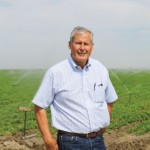You Can Have Water Sustainability on the Farm

When the King River in California floods, a system of pumps and canals will divert the overflow onto Terranova Ranch’s fruit and vegetable fields.
Photo courtesy of Terranova Ranch
I started farming in 1981, and the attitude at that time was, “Drill whatever wells you need; pump whatever groundwater you need.” Back then, we used 75- and 100-horsepower wells to get the volume of water we needed. It was just a matter of how much the power cost to pump the water. Water conservation wasn’t really on anyone’s mind because it wasn’t a big issue. It was a matter of if you could pay for it and be profitable growing.
Over time, however, I began to see that the water table was dropping at a rate of about two feet per year. The weather and climate didn’t have a lot of effect on the water level. We had flood periods and dry periods, but we continued to see a drop in the groundwater reserves of about 2 feet per year.
I realized early on that this was a no-win situation. At some point, we were going to run out of water. We had a lot of water storage below us, but as you continue to drop your water table, your electric costs go up to support pumping the water from new depths.
Today, we run 200- to 250-horsepower motors to get the same amount of water out of the ground. And we’ve had wells go dry over the last 10 to 15 years.
Finding Sustainable Solutions
I’ve probably been working on trying to find a solution for over 25 years. We started by doing some tests to see what kind of soil structure we had and whether it would be suitable for groundwater recharge or if we had clay that would prohibit that. For the most part, we found that we could put water on the top of our soils, and it would infiltrate down to the water table.
Want to see the system in person? Join the Pre-Show Tour for BioSolutions Conference & Expo March 4!
We’ve learned a lot in the past 25 or 30 years, but we got serious back in 2010 when the farm had a visit from the chief of the USDA-NRCS (Natural Resources Conservation Service). At that time, it was David White. He visited the farm.
When we met, I told him I had this idea to do groundwater recharge in our region. This meant taking floodwater from the North Fork of the King River, which was causing flooding downstream, and divert it onto our land. We ended up getting a $75,000 grant from the NRCS, and we matched it with another $75,000.
We worked with Phil Bashar, a research engineer from UC Davis, who wrote the initial grant. After the grant was accepted, Bashar came down, and we designed the plan for how we were going to divert the water and get it onto our land.
Then in 2011, lo and behold, we had some flood water show up. It had been a dry year, so this was somewhat of a surprise. We began our project this year, flooding the wine grapes and open ground from February all the way till the end of May.
It was a very simple system, but we were able to put more water on more than 5,000 acres in different fields. We proved this concept could work, so we went looking for more money to scale up our project. In 2012, we received a $5 million grant to take floodwater off the King River and prevent flooding downstream. Terranova put in $2 million to help fund this project.
Scaling Up
We had to go through environmental verification processes, engineering, permitting, cultural studies and a whole lot of red tape before we could actually get started building the infrastructure. Because of all the delays, our project costs went from $7 million to somewhere between $11 and $12 million. These are additional expenses that we’ve had to fund.
In 2014, the governor signed the Groundwater Sustainability Management Act. Farmers in the area were just starting to hear about this legislation and its effects. Soon, the light began to come on for some of our neighbors. They realized that this recharge project could help keep them farming their ground in the future when controls might come into place on groundwater pumping. Now, our neighbors support this initiative wholeheartedly. Back then, though, they thought I was crazy when I flooded our wine grapes for months on end.
We began phase one of the project in October 2018, and we will finish that at the end of 2019 or in early 2020. Phase one encompasses our farming operation and covers about 6,000 acres. The project was designed to be scaled up. So we can eventually expand it to the east and north, covering 80,000 acres and include other growers in the region. We tell people that we built a four-lane highway.
If You Build It…
In the mid-1990s, we built about a mile-long canal from the King River that cost us $25,000 and took three weeks from start to finish. There wasn’t any permitting, so we just did it.
For this project, we went back in and put control gates right up the river, and then, we put a large canal that travels to the north east for about a mile. With the canals in place, we’re building the pumping stations. We’re putting in the pumps and piping that will take the water to the next set of canals.
Essentially, the infrastructure moves the water from the north fork of the King River onto and throughout the farmland. That allows us to then put it on the fields and recharge the groundwater. We’re also putting up a berm or small levy around our fields to help hold the water in. And we’re creating little dams around the field, so we can hold more water when it comes. It’s a really involved process.
Betting the Farm on Groundwater Recharge
I knew that flooding our grapes wouldn’t kill them. Back in 1983 when Silicon Valley had record flooding, I would drive along the San Joaquin River up to the farm. I noticed in the bottom of the river channel that there was a vineyard. It had water that was probably four feet deep. The water stayed from January until the first of August, and I watched the grapes continued to grow through the spring and early summer, and eventually, they dropped the water.
I stored this tidbit of information away. It came in handy when we started our project. I knew if we were careful, we wouldn’t kill the grapes. We did, however, watch the grapes closely.
In late May, when the air temperature got up above 95 degrees, we found the grapevines developed issues from warm water temperatures in the fields. Cold water holds more oxygen, so when the water warmed, the grapevine started to turn a bright yellow. We immediately drained the water below the root zone. And within 10 days, the vineyards were a beautiful dark green again. We ended up having a normal harvest.
Since we started this initiative, we’ve flooded olives, almonds and walnuts. We experimented as we went along, and we found that you can do it with almost any crop. We’ve learned a lot. I’ve personally gained a lot of patience for doing things that I didn’t have before. And I found out that projects always seem to go longer or cost more than what you expect.











